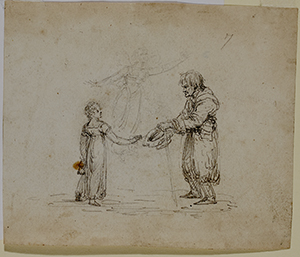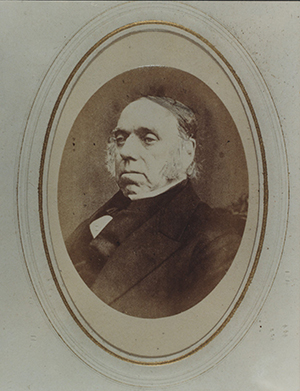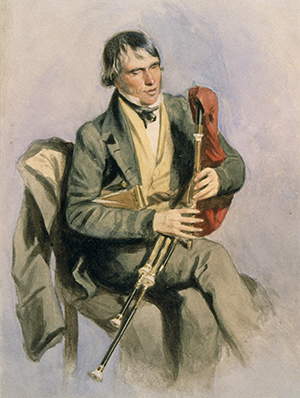‘The last of the shanachies’ and the professor
Published in 18th-19th Century Social Perspectives, 18th–19th - Century History, Features, Issue 2 (March/April 2019), Volume 27Thady McMahon, Eugene O’Curry and singing beggars in mid-nineteenth-century Dublin.
By Ciarán McCabe

In November 1852 a 60-year-old blind beggar named Thady McMahon was arrested and detained in Dublin city for ‘being a wandering vagrant’. With three or four previous convictions ‘for vagrancy’, McMahon was sentenced before the magistrates at the Capel Street Police Office on 18 November to fourteen days’ imprisonment at the Richmond Bridewell. Two days later a submission in McMahon’s favour was sent to the lord lieutenant, the earl of Eglinton, at Dublin Castle by the Irish-language scholar Eugene O’Curry, later professor of Irish history and archaeology at the Catholic University in Dublin. Petitioning the lord lieutenant was a common practice in nineteenth-century Ireland, constituting effectively the only chance of obtaining clemency and a commutation of sentence. Petitions were sent either by convicts or by persons on their behalf, and each case was thoroughly investigated by the Dublin Castle administration through correspondence with the trial judge, the arresting police officer(s) and the governor of the local gaol, with mitigating circumstances or aggravating factors being identified and considered. The National Archives of Ireland (NAI) holds thousands of these petitions, contained in the Prisoners’ Petitions and Cases (1778–1835), Convict Reference Files (1836–1922) and Criminal Index Files (1842–1920): more than 10,000 convict petitions for the period 1836 to 1922 are held by the NAI.
Eugene O’Curry’s letter pleaded for leniency for McMahon, whom he presented as an unparalleled repository of Irish airs:
‘A blind man named Thady McMahon from Clare has been taken up and lodged in the Richmond penitentiary. I met him accidentally in the act of singing an Irish song and so well did he know the words and the air that I took him to my house and wrote from his dictation several songs and airs which I had long been looking for. The distinguished antiquary [George] Petrie had engaged him to attend at his house at Rathmines to take down from his lips some unequal’d Irish airs. May I then beseech Your Excellency to exercise your wonted benevolence in favour of this very poor man—a very decent individual by ordering him his liberty.’
As with all petitions on behalf of convicted criminals, the matter was investigated by Dublin Castle. Sergeant Daniel Ryan of the Metropolitan Police Office at Exchange Court informed the Commissioners of Police that ‘nothing dishonest is known here by the Police of the prisoner’, while relaying the fact that ‘Doctor Kelly, magistrate of Capel St Police Court, who committed McMahon, states that earlier applications have been made to him, by members of the Royal Irish Academy for his release, as the society is at a loss for him’. Sergeant Ryan stated that, in Kelly’s opinion, ‘it would be a charity to liberate the prisoner’. McMahon was subsequently released before the end of his fourteen-day sentence.

Well acquainted with Dublin’s intellectual élite
McMahon’s case was unusual. The intervention of members of an intellectual élite on behalf of a convicted vagrant—and a recidivist, no less—is unrepresentative of the numerous similar cases that were prosecuted during this period. What can be drawn out of this vignette, however, is the positive representation of a mendicant; to stretch the point further, the beggar was actually portrayed as a useful figure to society, and even a person of cultural importance. McMahon, a native Irish-speaker who had very little English, was one of the key sources of songs for George Petrie’s Collection of the ancient music of Ireland (1855).Attributions to McMahon are littered throughout Petrie’s monumental published collections of Irish music and these references are suffused with respect, familiarity and affection. For instance, introducing Ag an mboithrín buidhe (‘At the yellow little road’), Petrie stated:
‘The following melody, together with the Irish words still sung to it, was noted down during the present year [1855] from the singing of Teige Mac Mahon, a county of Clare peasant, now unhappily blind and pauperised, but whose memory is still a rich depository of the fine tunes of his native county’.
In his notes for Suig annso a Múirnín lámh liom (‘Sit here, Murneen, near me’), Petrie records teasingly: ‘This tune was noted from the singing of Teige MacMahon—but the words are unfit for publication’.
McMahon, hailed three decades later as the ‘last of the shanachies’, learned his ancient trade at the feet of the legendary storyteller Peter O’Connell. He came to Dublin to receive treatment for a cataract, and after being ‘discovered’ by O’Curry he became well acquainted with some of the most prominent figures in mid-nineteenth-century Dublin’s intellectual circles, individuals significant enough to warrant entries in the Dictionary of Irish biography. In an interview with O’Connell’s daughter Mary Anne (a biographer of transport entrepreneur Charles Bianconi) in the 1880s, when McMahon was an inmate in the Kildysart workhouse in his native County Clare, the beggar revealed that during his time in Dublin his associates included scholar and librarian Dr James Henthorn Todd, a member of the Royal Irish Academy who, along with O’Curry and John O’Donovan, founded the Irish Archaeological Society; surgeon and politician Dr Robert Spencer Dyer Lyons, who was a member of the Royal Irish Academy and a close associate of John Henry Newman; Lyons’s brother-in-law, the lawyer and Young Irelander John Edward Pigot, who was a member of the Royal Irish Academy, the Irish Archaeological Society, the Celtic Society and the Society for the Preservation and Publication of the Melodies of Ireland, as well as being a friend of Petrie’s and a prolific collector of traditional airs; Fenian John O’Mahony, an accomplished Gaelic scholar; Patrick Weston Joyce, a historian, linguist, collector of folk music and collaborator of Petrie’s; physician and antiquarian enthusiast William Stokes, who was a friend of Petrie’s; and Stokes’s son Whitley, a renowned Celtic scholar.
‘A thoroughly cheery and contented pauper’
It appears that McMahon was treated well by his new associates in Dublin. His 1886 interviewer wrote:
‘Many a tumbler of punch has Teague partaken of in a corner of [Petrie’s] diningroom while “singing songs, and the doctor [most likely Petrie] playing them on the fiddle”, and some other tricean “taking them down”.’
McMahon, who apparently returned to Clare of his own accord, was portrayed by his interviewer as enjoying a privileged position among the paupers in the Kildysart workhouse, receiving a regular supply of newspapers and tobacco from O’Mahony. Furthermore, and with some literary hyperbole, he was presented to the reader as living a blissful life in the workhouse, proudly sharing his fond recollections of his time in the company of the academic élite in Dublin. O’Connell wrote that ‘he is, in fact, the only thoroughly happy person I ever saw in a workhouse’ and, later, ‘the last of the shanachies is … that phenomenon, a thoroughly cheery and contented pauper’.

From Petrie’s collection it is evident that McMahon was not the only pauper to whom Gaelic scholars resorted in their pursuit of the words and airs to ancient Irish songs. A County Limerick woman named Mary Madden, described by Petrie as ‘a poor blind peasant woman from Limerick, now resident in Dublin’, was also the source of many ancient songs, while the antiquarian also patronised the legendary Galway piper Paddy Conneely, who rose to fame after the publication of an article by Petrie (with an accompanying sketch by Frederic William Burton) in the Irish Penny Journal on 3 October 1840. McMahon and Madden are significant in being the sources of a considerable amount of folkloric material provided to the leading Gaelic scholars in nineteenth-century Ireland. Furthermore, they constituted personified examples of the traditional popular associations between wandering beggars and storytelling. The examples of McMahon and Madden support the conclusions of George Zimmerman, who has analysed the recording of this tradition by the proto-folklorists of the early to mid-nineteenth century. Zimmerman quotes antiquarian John Windele’s account of encountering such individuals in west Cork in the 1820s:
‘Here we found … a veritable sample of our genuine Irish boccaugh [bacaigh], a race for whom I entertain an ancient liking. I have always regarded them as reliques of our old Irish Society; the representatives of those numerous tribes of Carrouchs [cearrbhaig: gamblers]—Stocachs [stócaigh: youths]—tale-tellers and gillys, who once pursued their vagabond vocation, administering to the pleasure and entertainment of thanes and their retainers, in the old feudal halls and chambers, incurring by their attainment to the native chiefs, the displeasure of the poet Spen(s)er.’
For Windele the itinerant bard was ‘the repository of all the legends and marvels of his own and of former times’, while another storytelling beggar is described by Windele as enjoying the ‘superstitious veneration’ of the lower orders and in the habit of coming to the peasant’s home equipped with news regarding neighbouring families, before outlining ‘the genealogy of their parents and their connections’.
The fascinating case of Thady McMahon throws light on the tradition of the wandering mendicant as storyteller and a link to older popular customs. McMahon was a walking personification of the character of Edie Ochiltree in Walter Scott’s The antiquary (1816), who was portrayed by Scott as ‘the news-carrier, the minstrel, and sometimes the historian of the district’. While itinerant beggars were usually depicted in nineteenth-century sources—albeit in sources created by middle-class commentators—as deviant figures, spreading disease, immorality and sedition throughout the country, vagrants, especially in rural areas, were widely viewed as spreaders of news and gossip, which could carry both positive and negative connotations. As one witness commented of vagrants to the Whately Poor Inquiry of the mid-1830s, ‘in fabricating and spreading stories, “they are equal to a telegraph”’.
Ciarán McCabe is an Irish Research Council postdoctoral fellow in the School of History, UCD, and is the author of Begging, charity and religion in pre-Famine Ireland (Liverpool University Press, 2018).
READ MORE:
FURTHER READING
D. Cooper (ed.), The Petrie collection of ancient music of Ireland (Cork, 2002).
N. Ó Ciosáin, Ireland in official print culture, 1800–1850: a new reading of the Poor Inquiry (Oxford, 2014).
G.D. Zimmerman, The Irish storyteller (Dublin, 2001).
















